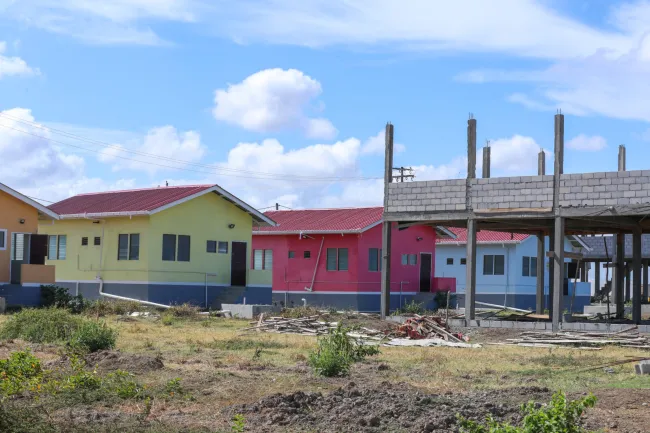Close

The Government of Guyana has made transformative strides in fulfilling its promise to provide affordable housing solutions to thousands of citizens. Among the administration’s most impactful commitments was the pledge to allocate 50,000 low-income house lots nationwide—a promise that is well on its way to being fulfilled. As of 2024, more than 40,000 house lots have already been distributed, with a further 25,000 projected for allocation in 2025, ensuring stability and homeownership for even more families across the country (Department of Public Information).
Region 4—Guyana’s most populous administrative region—has seen the lion’s share of housing developments, reflecting both the demand for land and the government’s effort to reduce urban overcrowding. Areas such as Great Diamond, Prospect, Little Diamond, and Farm have been rapidly developed, equipped with essential infrastructure such as roads, water supply, and electricity to support thriving communities. The Ministry of Housing and Water has been instrumental in executing this vision, hosting regular land allocation exercises to meet the surging public demand (Ministry of Housing and Water).
This nationwide housing push is more than just a numbers game. It’s about building stable, prosperous futures for thousands of Guyanese families. The initiative is strategically linked with the government’s broader socioeconomic development plan, which aims to reduce poverty, promote equity, and foster generational wealth through homeownership. Each land title granted not only gives families a place to live, but also unlocks access to financing and the security needed to invest in long-term development.
To ensure the lots remain accessible to low-income earners, the government has maintained subsidized rates and introduced flexible payment schemes. In addition, the allocation process has been increasingly digitized to improve transparency, reduce corruption, and accelerate delivery (Guyana Chronicle).
Minister of Housing and Water Collin Croal recently reaffirmed the administration’s commitment to delivering the remaining 25,000 lots in 2025, emphasizing that the goal is not just to meet targets, but to empower citizens with the dignity of owning a piece of Guyana (Stabroek News).
The significant progress made in land distribution reflects a government not just fulfilling promises, but reshaping lives. It is a testament to a vision rooted in inclusion, stability, and long-term national growth. This is what real progress looks like.

The Guyana Project is an independent media platform delivering fact-checked, ground-level reporting on politics, economy, and public life in Guyana. With a focus on transparency and development, we bring unfiltered news and thoughtful analysis to help shape a more informed, forward-looking nation.


Lorem Ipsum is simply dummy text of the printing and typesetting industry. Lorem Ipsum has been the industry’s standard dummy text ever since the 1500s, when an unknown printer took a galley of type and scrambled it to make a type specimen book. It has survived not only five centuries, but also the leap into electronic typesetting, remaining essentially unchanged. It was popularised in the 1960s with the release of Letraset sheets containing Lorem Ipsum passages, and more recently with desktop publishing software like Aldus PageMaker including versions of Lorem Ipsum.
t is a long established fact that a reader will be distracted by the readable content of a page when looking at its layout. The point of using Lorem Ipsum is that it has a more-or-less normal distribution of letters, as opposed to using ‘Content here, content here’, making it look like readable English. Many desktop publishing packages and web page editors now use Lorem Ipsum as their default model text, and a search for ‘lorem ipsum’ will uncover many web sites still in their infancy. Various versions have evolved over the years, sometimes by accident, sometimes on purpose (injected humour and the like).
Contrary to popular belief, Lorem Ipsum is not simply random text. It has roots in a piece of classical Latin literature from 45 BC, making it over 2000 years old. Richard McClintock, a Latin professor at Hampden-Sydney College in Virginia, looked up one of the more obscure Latin words, consectetur, from a Lorem Ipsum passage, and going through the cites of the word in classical literature, discovered the undoubtable source. Lorem Ipsum comes from sections 1.10.32 and 1.10.33 of “de Finibus Bonorum et Malorum” (The Extremes of Good and Evil) by Cicero, written in 45 BC. This book is a treatise on the theory of ethics, very popular during the Renaissance. The first line of Lorem Ipsum, “Lorem ipsum dolor sit amet..”, comes from a line in section 1.10.32.